Stories and recipes from the farmers’ markets
by Michelle Peters-Jones
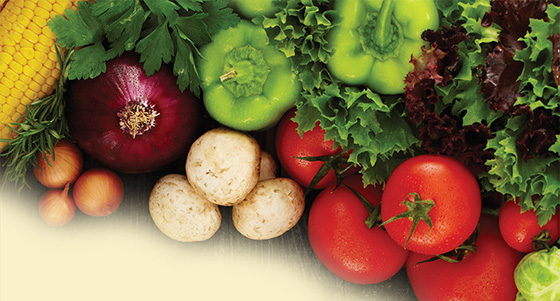
My family and I moved to Edmonton in February, just over six years ago. As we were moving, we heard a lot of stories about how gorgeous summers here are, but let’s face it, when you’re dealing with sub-zero temperatures for the first time in your life, it is really hard to imagine a bright, sunny, hot summer with green trees, fragrant flowers and farmers’ markets with an abundance of produce. I might have even asked, in shock after a late May snowstorm, if the snow would ever melt and go away.
Turns out ‘they’ were right, summer did arrive in all its glory, and my tropical soul started rejoicing. I still remember my first trip down to the Old Strathcona Farmers’ Market. It was a sunny Saturday, and accompanied by my bouncing three year old, we walked to the market. As we got near, I started seeing people carrying back fresh tomatoes, cucumbers and eggplants, and before I knew it, I was walking through the stalls, marvelling at everything that I never thought I’d get in Edmonton. Fresh and colourful produce heaped on pallets and the hustle and bustle of the market reminded me so much of my beloved outdoor Indian markets, albeit more polite and with less yelling and bargaining.
After that first trip, I’ve made many, many more trips to the markets, delighting at the urban City Market, and looking forward to the others opening up almost yearly. I am always guaranteed to find vendors I love and visit, shooting the breeze as well as learning so much about their lives.
For me, summer cooking is light and easy, relying on the fresh produce and meats from the markets, and making sure that these ingredients shine. I love being inspired by my own culture, and those in which I have travelled, bringing together local flavours with global flair. Summers are also about parties and drinks and lounging with friends in back gardens, and the recipes I have here reflect my favourite season of the year. As much as Edmonton would like to call itself a winter city, summer is really where it’s at.
As it should be!
Serben’s Organic Farms
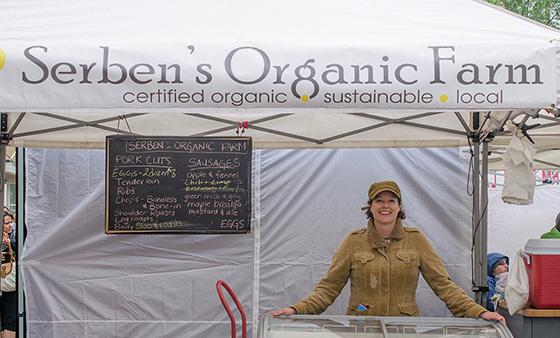
I am always curious about farms that have been in the same family for decades. Serben’s Organic Farms, previously Serben’s Free Range, is now currently in the fifth generation. I asked Julia, one of the owners of the farm, if she saw the farm passing into the sixth generation (she and Jerod, her husband, have three kids.) She laughed—her four-year-old boy definitely wants to take over the farm, she says. Though his real ambition is to be a zookeeper, I guess that’s not so much different from being a farmer now, eh?
Serben’s Organic Farms went organic a few years ago, and Julia and Jerod believe that was the best decision they’ve made. It’s not always easy to be certified organic. Their farm is inspected regularly, they have a defined set of rules, and the hogs they raise are provided an organic diet. Julia readily admits that it is more expensive to run an organic farm, but as she puts it, the response from their customers has been worth the effort. She talks to me about their vision, a vision of making sure that everything they do on the farm is transparent and earth friendly. Jerod and Julia are particularly excited about their new processing facility on the farm, which gives them control over the pork products and the ability to give customers exactly what they want. Originally Serben’s also raised poultry and lamb, but they cut down on their species to adhere to the organic status and now only raise hogs and eggs.
As for challenges, well, Serben’s is a family farm, and Julia reckons that they face the same challenges any small business would. With just a few of them working the farm, they work long, hard hours with not many breaks, necessary to keep the farm going. They do love coming to the market however, rain or shine (Jerod was warming up in the van while I talked to Julia), as they get a chance to interact with their customers and get feedback on their products.
Goan-Spiced Pork Pies
To make the best use of the delicious, flavour- packed pork from Serben’s Organic Farm, I decided to incorporate my own heritage into this recipe. Growing up on the edges of Goan culture, pork has always been an important protein in our diet. Goan food has several pork recipes, from the traditional vindaloo, to a sweeter, pickled version called indad, and a long, slow cooked curry, the bafat. When the Portuguese colonized Goa, they brought with them many of their own dishes, which were then adapted by the Goans with spices and heat. These pork pies, also called empadinhas, are a classic combination of Portuguese and Goan culinary traditions. Spicy, tangy pork is encased in buttery puff pastry, making for the perfect appetizer or light lunch. The Goans would serve this with their local tipple, a small shot of cashew fruit liqueur called feni, but you can spare yourself that taste, and serve these pies as appetizers at a garden party, pairing them with a chilled gin and tonic with a twist of lime.
| 500 g | ground pork |
| 1 | small onion, finely chopped |
| 1″ nub | ginger, grated |
| 4 cloves | garlic, crushed |
| 1 | red or green hot bird’s eye chile, finely chopped |
| 2 T | red wine vinegar, plus extra to taste |
| ¼ c | hot water |
| 1 t | sugar, or to taste |
| salt to taste | |
| 4 sheets | pre-rolled puff pastry |
| 1 | egg, beaten |
Spice Mix
| 5 | cloves, whole |
| 5 | peppercorns |
| 1 t | whole cumin |
| ½ t | ground cinnamon |
| 1 t | mild cayenne pepper (to taste) |
| 1 T | sweet paprika |
Make the spice mix. Place the cloves, peppercorns and whole cumin in a small pan and toast them, tossing together, for about 30 seconds, until warm. Add the remaining spices, transfer to a spice blender and blend to a fine powder. Set aside.
In a heavy pan add the oil over medium-high heat, sauté the onion for 5-7 minutes until it begins to brown around the edges.
Add the ginger, garlic and chile and sauté for another minute or so until the garlic is fragrant.
Add the spice mix, and stir gently for 3-4 minutes adding a couple tablespoons of water if the mixture seems too dry.
Mix in the ground pork and red wine vinegar and sauté for about 10 minutes, until the pork is cooked, adding more water if the pork is too dry. Season to taste with salt and the sugar. The mixture should be tangy and spicy with a hint of sweetness. Let this mixture cool completely, or refrigerate overnight.
When ready to make the pies line a baking tray with parchment paper.
Using a cookie cutter, cut out rounds of the puff pastry. Place half the rounds on the baking tray and spoon a little filling into the middle of each round and brush with a little egg wash around the edges.
Carefully place another round of pastry on top of the filling and press gently around the edges to seal.
Brush more egg wash over the pies being careful not to leave drips. Use a sharp knife to make a small hole in the centre to let the steam escape. Chill the prepared pies.
Meanwhile, preheat oven to 425°F. Bake the pies for 15-20 minutes until the pastry has risen and is golden brown.
Serve warm or cold. Makes 10-12 small pies.
J–Conn Farms, Quail Products, Eggs and Meat
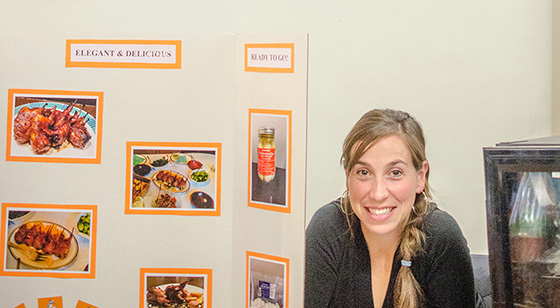
J-Conn Farms are based just east of Camrose, and are a family farm raising quail for over 25 years, having got into it almost by accident. They are a recent vendor at Old Strathcona Farmers’ Market, and I bumped into Julianne when purchasing quail for my last recipe feature in The Tomato, and was curious about the farm and their products. Julianne and her husband took over the farm from his parents about six years ago and have concentrated on expanding it and educating people about quail meat, eggs and products.
The quail at J-Conn Farms are all raised from scratch, they don’t use a hatchery and they are able to control the quality of the birds they raise with no antibiotics or hormones. They collect eggs and package them everyday to ensure freshness. The farm also owns their own provincially inspected processing facility, and as Julianne puts it, it is useful for them to know and be able to control the products they sell, and to make sure that there is no cross-contamination during the butchery process. This keeps the entire farm and their products as local as possible.
One of Julianne’s best selling products is their pickled quail eggs, and she is blown away by how such a simple product can be so well loved by their customers. She loves talking to people at the market about quail meat, especially as it is not as well known as chicken.
She loves that people are getting more adventurous and willing to try different kinds of local products though, and it helps that she can talk people through it.
Quail Egg Shakshuka with Cherry Tomatoes
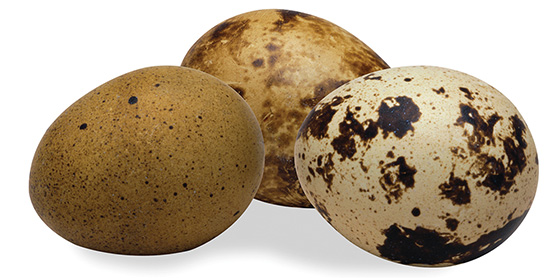
Quail eggs are perfect for a quick breakfast or dinner, and I love the combination of sweet and savoury in shakshuka, aka baked eggs in tomatoes. This Middle Eastern dish is the epitome of a simple breakfast, and is usually served with fresh pita or bread to mop up all that delicious sauce. I love using local cherry tomatoes from Gull Valley Farms, onions from Riverbend Farms, red peppers from Doef’s and herbs from Morinville Greenhouses. To me, this dish just screams summer. You can serve it all in one skillet, or if you want to do a fancier brunch, make up little individual cast iron pans for each person. The delicate flavours work well with the smoky spices, and you can also adjust the spice levels to your own taste. I’ve kept this relatively mild, to let the quail eggs and cherry tomatoes shine, but you can always add extra spice to punch it up.
| 1 T | olive oil |
| 1 | small onion, finely diced |
| 1 | small red pepper, finely diced |
| 1 fat clove | garlic, crushed |
| ½ t | ground cumin |
| ½ t | mild ground cayenne pepper |
| ½ t | paprika |
| 450 g | sweet red and yellow cherry tomatoes, halved |
| 12 | quail eggs |
| freshly ground black pepper, to season |
|
| 1 | small handful each, fresh cilantro and parsley, finely chopped |
| 4 | pitas, warmed and quartered, to serve |
Preheat oven to 375°F.
Place the oil in a large, heavy, oven-safe skillet on a medium heat. Add the onions and the red pepper and fry together for about 10 minutes, until softened. Add the garlic, and sauté for a minute.
Add the cumin, cayenne pepper and paprika, along with a little salt. Cook for an additional minute until fragrant.
Add the cherry tomatoes and cook, stirring, until the tomatoes start to wilt and release their juices, but are still relatively whole, about 7-8 minutes. Taste and season again if desired, with salt.
Carefully make 12 small indents in the tomato mixture, circling around the pan. Break a quail egg into each indent. Transfer the skillet to the oven and bake for 4-5 minutes, until the whites are just set.
Remove from the oven and serve with a sprinkling of fresh ground black pepper and the cilantro and parsley scattered on top. Serve with the warm pita breads.
Serves 4.
Coal Lake Honey Farms
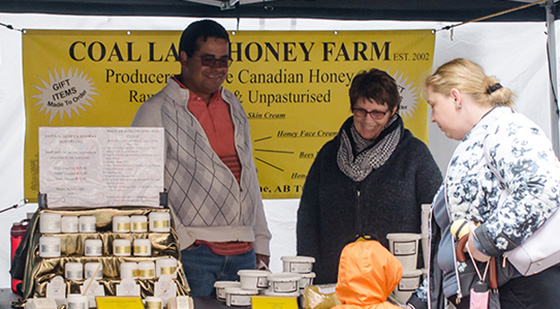
From the shipbuilding town of Cumbria in England to rural Alberta is quite the journey, but Christine and Joe Kent made it, along with their two daughters in 2000, in search of better opportunities for the family. Joe had been an avid beekeeper in England since he was 11, and at 68 he’s still going pretty strong with his passion. Joe and Christine decided to follow the same path here in Alberta, starting Coal Lake Honey with four hives and expanding to just about 250.
For Christine and Joe, the day starts in the fields when they extract the honey from their hives and then take it to their Honey House where they package it and also process it into other products. Their two daughters, Emma and Stella, both qualified teachers, help in the summers, keeping Coal Lake Honey
a family-owned and operated farm. Christine strongly believes in the health benefits of raw honey, and their honey is unprocessed, creamy and unpasteurized, though if you want it runny, all you have to do is melt it down. As sheputs it, the honey is kept as natural as possible.
Both Joe and Christine are at a lot of markets in the area, and Christine loves talking to people and explaining to them the philosophy behind what they do. Like most farmers, they are thankful for the good years, and do worry about years when there can be diseases that can take out bees. But they have been lucky so far, and except for one bad year, they have definitely had more successes than failures. While the job itself can be quite hectic and intense, neither Joe nor Christine have any intention of slowing down just yet.
Coal Lake Honey is definitely a business that is born out of love. As Christine puts it, we all have to do something, and what better to do than something that you love in the first place.
Ginger, Lemon and Honey Ice Cream
There is nothing better in the summer than sitting outside and scooping in cold frozen bites of freshly-made ice cream. This is a tangy, sweet and fresh ice cream, and one of my absolute favourite ones to make in the summer. Being a Philadelphia-style ice cream, it doesn’t need a custard base. Instead it is kept very light by using a lighter half and half cream and relying on the ginger and citrus to keep it creamy and smooth.
An ice cream machine is your best bet for making this treat in a hurry, but if you don’t have one, I’ve also included a way to make this without a machine. Homemade ice cream does tend to freeze harder than regular store bought, so take the container out a few minutes before serving. I love to serve this ice cream with fresh honey drizzled on top, which adds a slight chewiness to this summer treat.
| 125 ml | freshly squeezed lemon juice |
| 1-inch nub | ginger, grated, with juice strained out |
| ¼ c | sugar |
| 4 T | honey |
| 2 c | pinch of salt |
| ¼ c | candied ginger, finely chopped (optional) |
| extra honey, to serve, melted if creamed |
Place the lemon juice, ginger juice, sugar and honey in a small blender or food processor. Blend until the sugar dissolves.
Taste, adding a bit more honey, if you would like it sweeter.
Add the half and half and salt to the blender and blend until well mixed and the cream has thickened, about 1-2 minutes.
Transfer to an ice cream machine and churn, following its instructions, until creamy, adding the chopped candied ginger, if using, at the last minute.
Transfer to a freezer-safe container and chill for at least 2 hours, before serving.
If you don’t have an ice cream machine, place the prepared mixture, without the honey, into a freezer-safe container, stir in the ginger bits and freeze for about 2 hours. Take out and whisk to break up the ice crystals, repeating this step every hour for 2 more hours. Swirl in the honey, then leave to freeze overnight.
Serve out scoops with extra honey drizzled on top.
Makes about a quart.